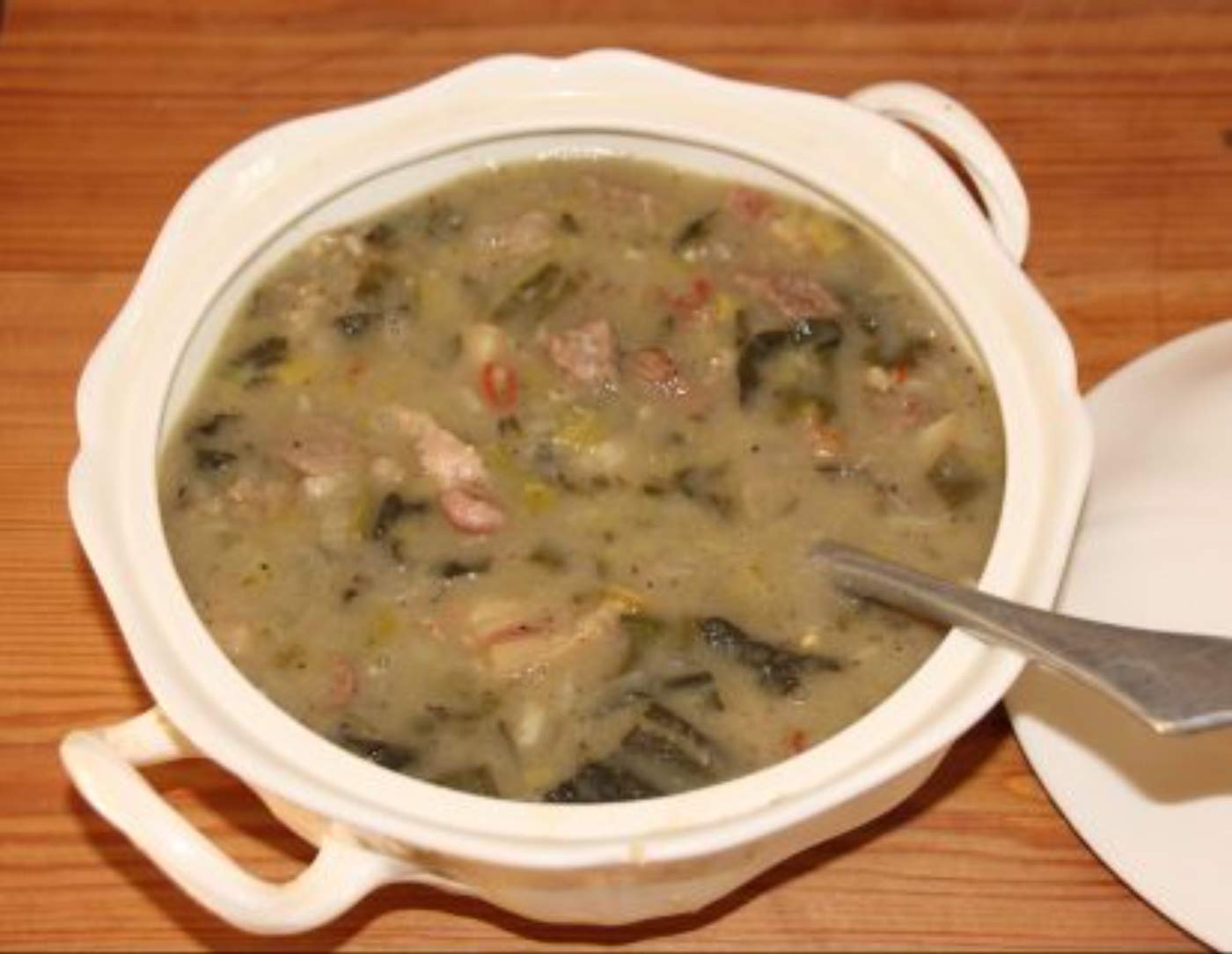Learn about this recipe from our historic foodways staff, then try it at home
Pepper Pot soup started as an African stew. It followed the path of the slave trade to the West Indies and to the Atlantic coast of North America. Like many African dishes, the exact ingredients varied depending on what was available. The concept of creating a soup with the cheapest cuts of meat paired with starches, greens, and hot peppers is an old one. Enslaved people from West Africa carried this concept with them to the Caribbean and North America. The stew soon appeared on numerous Caribbean islands.
Even today, Pepper Pot soup is still popular in Jamaica, St. Vincent, and Guyana, where it is often served as a Christmas dinner. In the Caribbean, it takes on some new tastes with the addition of salted meats and cuts like beef feet and pig tails, all of which were common sources of food for the enslaved in the West Indies. The pepper may have also changed from the cayenne to the scotch bonnet and back again as the dish made its way to North America.
Our next stop is the Atlantic coast. The ports that conducted the most trade with the West Indies – Charleston, Norfolk, and Philadelphia — were the first to adopt the stew, with variations based on local foodstuffs. Some folks changed the recipe quite a bit while others just tweaked it by adding or removing a few ingredients.
The South Carolina version, which I find the most fascinating, appears in The Carolina Rice Kitchen cookbook attributed to Sarah Rutledge. This incarnation of Pepper Pot retains much of its African and West Indian heritage but adds some interesting Carolina twists.
Mrs. Rutledge starts with spinach, which would be a good local substitute for callaloo – or the tops of the Taro root — used in African and Caribbean versions. Beef and salted pork provide the base of the stew. For the starch, she calls for potatoes rather than yams and plantains, a nod to both Africa and Jamaica. All these are stewed together for four or five hours. The recipe finishes with cut-up pickled peppers and one or two long red peppers. Finally, the ultimate Coastal Carolina twist: “If you have crabs or lobsters previously boiled, add some of the meat picked clean and serve it with rice.”
Pepper Pot continued its journey, eventually finding a new home in Philadelphia. In the City of Brotherly Love the German influence changed the meats to beef tripe and veal knuckle, and it became a staple of the city’s cooking.
18th Century
“Take half a peck of spinach, pick and boil it as for dinner; drain off the water and chop it fine. Put into the soup kettle 6 quarts of water, 3 pounds of beef or veal, about 1 pound of pork which must be scalded to draw out the salt. A piece of ham with the ham bone in is preferable and boil it about an hour. Then add the spinach, a dozen potatoes, or four pounds of yam, 3 plantains peeled and cut up into pieces about 3 inches long. And small dumplings. Let all these ingredients boil together slowly for four or five hours. Just before serving ad some pickled peppers (cut up) and 1 or 2 long red peppers. If you have crabs or lobster previously boiled, add a small quantity picked fine about a half hour before serving. Serve with rice.”
— The Carolina Housewife by Mrs. Rutledge (1847)
21st Century
Ingredients
- 1 package spinach or collard greens
- 1 tablespoon cooking oil
- 6 potatoes
- 3 quarts water or stock
- 1 ham hock or 5 oz. sliced salted pork (Boil first to get rid of the excess salt)
- 1½ pounds stew beef
- ½ of a medium sized African yam*
- 2 plantains
- 2 long red peppers or one Scotch bonnet pepper
- 1 tablespoon black pepper
- 1 cup cooked rice
- Small dumplings (1 cup cornmeal, 1 cup flour, ½ stick of butter worked in to dry ingredients; add a cup of water and roll the dough into small marble sized balls)
- Optional: 1 cup of picked crab meat, garlic, onions, pickled peppers
Instructions
- Start by adding the salted pork to a small pan filled with water and bring to a boil for 30 minutes, remove the pork and set it aside.
- In a large stock pot heat the oil and fry the beef. Then add the water.
- Chop the spinach or collards to a size you like and add them to the pot. Then add the yam and potatoes, plantains and salted pork. Add the peppers and bring to a boil. Let simmer for at least two hours.
- The last 30 minutes add the dumplings and the crab (if using).
- Remove the ham hock and serve over rice.
*African yams are not sweet potatoes. They are a white or yellow tuber, with a skin that looks like the bark of a tree. When sliced they are slightly slimy, and have the taste of a lightly-sweetened white potato. Yams can be found in specialty, Asian, or ethnic markets, as well as certain chain super markets. If you cannot find yams substitute white potatoes.
